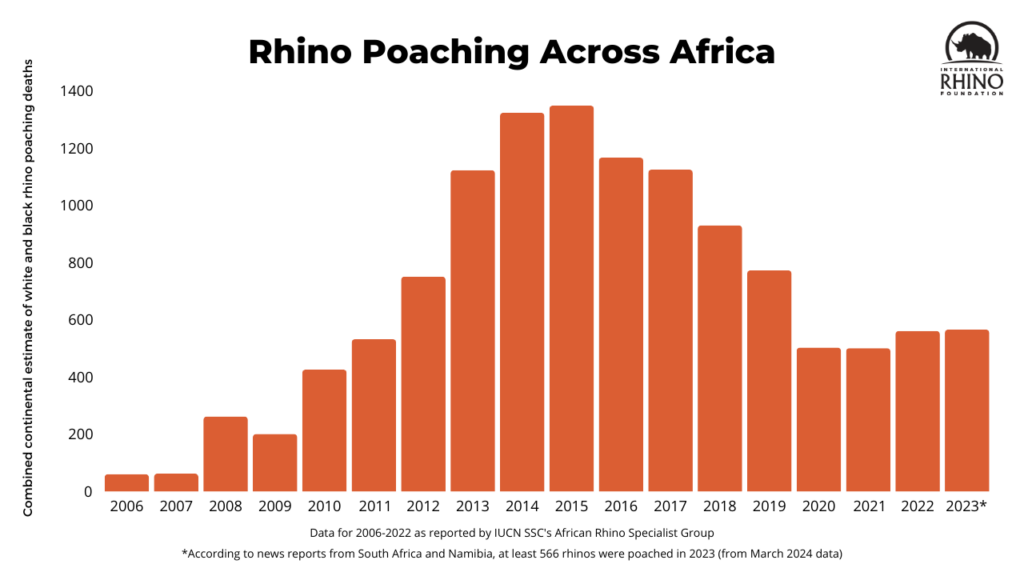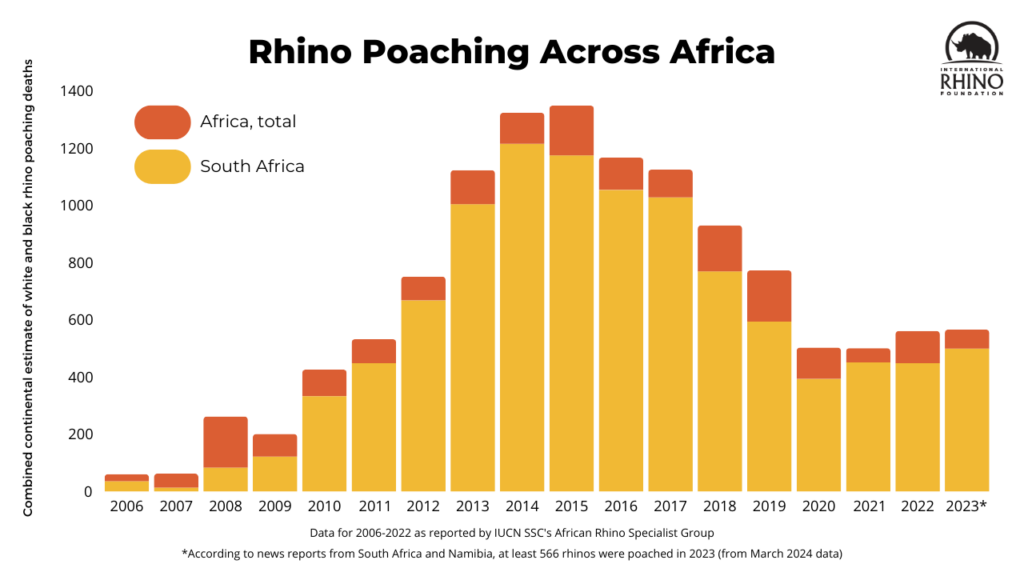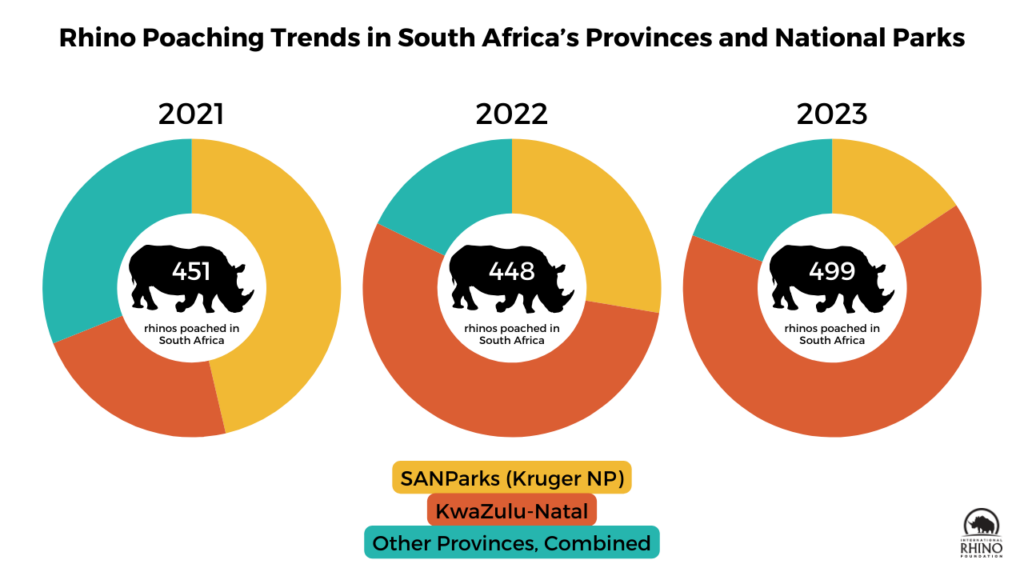
Poaching Remains the Biggest Threat to Rhinos
Poaching for rhino horn is the greatest threat to all five rhino species. At the start of the 20th century, an estimated 500,000 rhinos roamed the planet. Today there are just over 27,000 rhinos left in the wild, largely due to poaching.
Rhino poaching is carried out by locals, who are hired by criminal syndicates. These syndicates are part of highly-organized, transnational crime groups who illegally traffic rhino horn to sell on the black market, mostly in China and Vietnam.
Even though there is no scientific evidence that rhino horn has any medicinal value, sellers exploit consumers by claiming that rhino horn cures everything from fevers to cancer. In other markets, some in the wealthy business-class see rhino horn as a status symbol, using powdered horn as a party drug to prevent hangovers and carved pieces of horn as gifts to demonstrate wealth.
Rhinos are still being killed every day to fuel this demand. Without interventions, several rhino species could go extinct in our lifetime.
Latest Rhino Poaching News
INDONESIA 26 Apr 2024 A single gang of poachers may have killed 10% of Javan rhinos since 2019
NAMIBIA 3 Mar 2024 Namibia Faces Environmental Crisis: Deforestation, Emissions, and Poaching Threaten Wildlife
SOUTH AFRICA 27 Feb 2024 Rhino Poaching on the Rise
INDIA 27 Jan 2024 Two rhinos killed in a day: Are poachers returning to Kaziranga?
Rhino Poaching Statistics
- At least 566 rhinos were poached in Africa in 2023, several rhino range countries have yet to confirm their 2023 poaching figures.
- Today, a rhino is poached every 15 hours.
- From 2013 to 2017, the world lost more than 3 rhinos every single day to poaching.
- More than 12,000 rhinos have been poached in Africa since the start of the poaching crisis in 2008.
- South Africa, which has more than half of all the world’s rhinos, accounts for the majority of the world’s rhino poaching incidents.
How to Stop Rhino Poaching
The International Rhino Foundation was founded in response to the black rhino poaching crisis in the late 1980s. Working with partners to combat poaching and its effects on rhino populations remains one of our biggest priorities today. As long as there is demand for rhino horn, rhinos will always be threatened by poaching. Poaching is a complex problem that requires a multi-faceted solution. There is no one answer to solving the poaching crisis. A variety of scientifically-sound, collaborative strategies and tactics need to be deployed at local, national and international levels to give rhinos their best chance to survive.
IRF works with dedicated partners all over the world to combat poaching. The programs we support aim to decrease the demand for rhino horn, disrupt wildlife trafficking, deter wildlife crime through strengthened laws, prevent poaching through intelligence operations, provide advanced technologies and support to reserves and Parks with key populations of rhinos, provide salaries, supplies and trainings to rangers on the frontlines protecting rhinos and make rhino populations more resilient to poaching losses by monitoring and managing their populations.
Every moment counts and you can make a difference for rhinos today. Make a one-time gift, set up a monthly donation, or sponsor a K9 unit to keep rhinos protected from poachers.
Rhino Poaching in South Africa
Any country that has rhinos is susceptible to rhino poaching. With more rhinos than any other country in the world, South Africa also records the highest number of rhino poaching deaths every year.

The current poaching crisis in Africa began in 2008, when rhino deaths more than tripled from the year before. Every year since 2009, there have been more rhinos illegally killed in South Africa than in all other rhino range countries combined. In 2014, South Africa had its highest recorded number of rhino poaching deaths – 1,215 of the entire continent’s 1,324 rhino poaching losses. Africa’s rhino poaching crisis peaked in 2015, with 1,349 rhinos killed across the continent. Thanks to decisive action, speedy interventions and support from around the world, rhino poaching declined steadily until 2020, when a global shutdown of borders drastically reduced poaching and trafficking opportunities. Since then, poaching in South Africa has been slightly increasing year after year, with poaching syndicates shifting their strategies to target smaller, more concentrated rhino populations.
The latest rhino poaching statistics out of South Africa show that 499 rhinos were killed in 2023. Kruger National Park – once the hotspot for rhino poaching – had 78 rhinos killed in 2023, a decrease of 37% from 2022. The vast majority of poaching last year occurred in the province of KwaZulu-Natal, which had an alarming 325 rhinos poached – 307 of those deaths occurred in just one state park, Hluhluwe iMfolozi.

Read IRF’s latest State of the Rhino report for more information on current rhino populations and conservation initiatives around the world.

